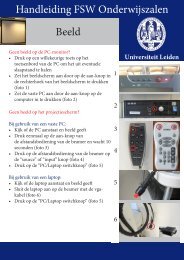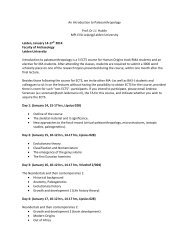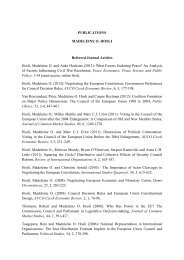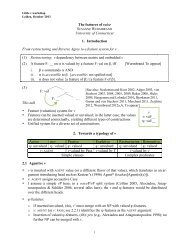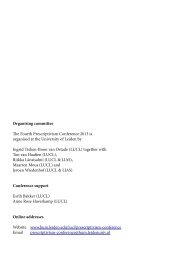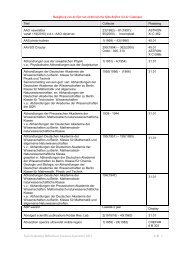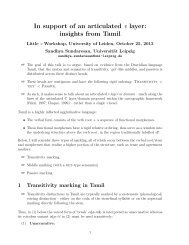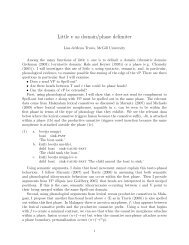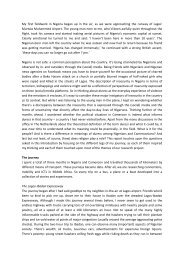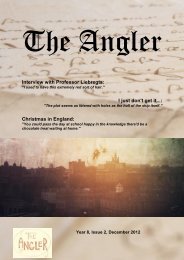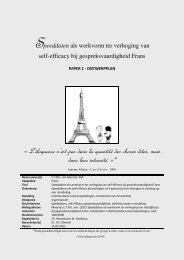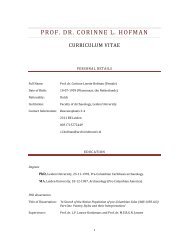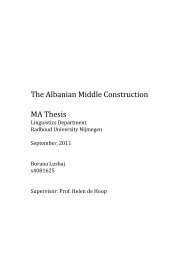Institute for History Annual Report 2010 - O - Universiteit Leiden
Institute for History Annual Report 2010 - O - Universiteit Leiden
Institute for History Annual Report 2010 - O - Universiteit Leiden
You also want an ePaper? Increase the reach of your titles
YUMPU automatically turns print PDFs into web optimized ePapers that Google loves.
memories? Could certain memories be adapted<br />
when new stories turned up? All these questions<br />
will play an important role in this project. In<br />
addition, this project seeks to explore local<br />
memory cultures as a multimedia phenomenon. It<br />
will be based on literary sources and archival<br />
material, but also on commemorative objects<br />
including paintings, prints and a wide range of<br />
material and immaterial objects – gable stones,<br />
tapestries, windows, ceramics, or ‘relics’ of the<br />
Revolt years, as well as local rituals, place names<br />
and lieux de mémoire. All these media have their<br />
own messages and audiences, they will be studied<br />
both individually and collectively in order to<br />
understand their position and meaning in the<br />
memory process.<br />
Exile memories and the reinvention of the<br />
Netherlands (PhD project)<br />
Johannes M. Müller<br />
This research project examines the role of memories<br />
of war and exile among Netherlandish refugees<br />
and their descendants in the Netherlands,<br />
Germany and England from the beginning of the<br />
Dutch Revolt until 1700. The main objective is to<br />
explain how and in which <strong>for</strong>ms images of the<br />
past lived on in the Dutch exile communities and<br />
how memories about the war and the lost homeland<br />
contributed to the <strong>for</strong>mation of new social<br />
identities in the Low Countries and abroad. To<br />
meet this objective, this study will focus on a) the<br />
social structures and institutions, through which<br />
memories were shaped and preserved, b) an<br />
analysis of the ‘semantics’ of exile, i.e. the social<br />
<strong>Institute</strong> <strong>for</strong> <strong>History</strong><br />
49<br />
meanings that were attributed to this phenomenon,<br />
and c) the changing topical and intertextual<br />
traditions in which exile memories were modelled<br />
and articulated. Leaving behind their hometowns<br />
and local social networks which were held<br />
together by mechanisms of trust and reputation,<br />
exiles were <strong>for</strong>ced to redefine themselves and to<br />
fashion identities that were acceptable and<br />
recognizable in the new society. Especially<br />
Southerners, who had fled to the Republic were<br />
immensely active in publishing pamphlets and<br />
other literature, in which they presented<br />
themselves as compatriots of their hosts,<br />
‘Netherlanders’, who sought refuge <strong>for</strong> the sake of<br />
their faith. Whereas the inhabitants of the Low<br />
Countries had previously defined themselves by<br />
referring to local rather than to national identities,<br />
exiles began to appeal to ‘the common fatherland’<br />
of all Netherlanders or to the unity of trans-local<br />
religious confessions. So far, the role exile<br />
memories played in the <strong>for</strong>mation of new<br />
confessional and ‘proto-national’ constructions of<br />
Netherlandish identity has scarcely been examined.<br />
This study will do so, in the belief that this<br />
can offer valuable insights into the development of<br />
two distinct Netherlandish states and identities as<br />
well as the emergence of new confessional selfimages.<br />
The politics of memory in the Low<br />
Countries (PhD project)<br />
Jasper van der Steen<br />
The Dutch Revolt tore apart the seventeen Netherlands<br />
and led to the <strong>for</strong>mation of two states that



